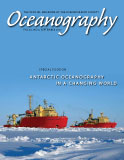Article Abstract
Various human activities, including fossil fuel combustion and forest clearing, emit about eight petagrams (or billion tons) of carbon in the form of CO2 into the atmosphere annually. The global ocean absorbs about two petagrams of CO2, and about a half of that amount is absorbed by the Southern Ocean south of 30°S, thus slowing the rapid accumulation of CO2 in the atmosphere. Partial pressure of CO2 (pCO2) is a measure of the chemical driving force for the CO2 exchange between the ocean and the atmosphere. This paper discusses its space and time distribution over the Southern Ocean. The major sink zone for atmospheric CO2 is located in a latitude belt between 30°S and 50°S, where the biological utilization of CO2 and cooling of warm subtropical waters flowing southward produce low seawater pCO2. Strong winds in this zone also enhance the ocean’s uptake. Although the source-sink conditions vary over a wide range through the seasons in the areas south of 50°S, this zone is a small sink on an annual average. Winter observations show that surface water pCO2 values in the source region for Antarctic Intermediate Water have increased at a rate faster than the atmospheric increase rate, suggesting that the ocean CO2 sink intensity has been weakening for several decades and has changed from a net sink to a net source since 2005. The results of ocean general circulation-biogeochemistry model studies are found to be consistent with the observations.

